Back to top: Overview
Introduction
The complete analysis of shape and body sherds excavated in many excavation units of Urkesh/Mozan is due to the hard work and efficient cooperation of the dedicated Ceramics Team. Working together in Mozan I wish to thank this ceramics team for the preparation and analysis of all the ceramics that have made this Overview possible: Hammade Hamza, Ibrahim Khellu, Ismail Mesto, Kamiran Faisal, Diadin Mustafa, Sami Hamza and Imad Hamza. In Mozan Marie-Claude Trémouille generously helped me to organize the Temple BA sherds in the Urkesh Ceramic Library, a large dedicated display room in the expedition house (Mozan/Urkesh Ceramic Library).
A significant amount of third millennium ceramics has been excavated in Urkesh dating to the first half of the millennium. The corpus of ED III ceramics excavated on the High Mound is much larger than the ED II corpus due to the many excavation units with this chronological horizon. The most extensive are the Temple BA excavations on the top of the High Mound in units B1-5, and the Temple Terrace excavations in units J1-3, J5. Other less extensive excavations with material dating to this time period occurred in area K1 (see especially pp. 61-5, 69-81) on the eastern edge of the High Mound. In the Outer City the most important excavations are in OH2 (OH2), a small excavation which yielded a portion of an administrative building located on the northeast. Additionally the surface collection in OD50 (OD50), located in the southeast portion of the Outer City, is probably to be dated early in ED III, that is, somewhat later than the ED II ceramics in Oa4 and Ob1 tombs, as it contains a wider variety of early Metallic ware shapes, more vessels made in Fine Chaff and Chaff Tempered wares including some interior grooved rim jars of the early type (Outer City).
Shapes found in ED III are shown in this ED III catalog; the shape catalog contains 114 jars (jars),
101 bowls (bowls), 25 cups (cups)), and 15 pots (pots), 1 miscellaneous for a total of 256 shapes illustrated.
In the right hand column the central portion (C2) is dedicated to an overall presentation of ceramic shapes from important strata (shape catalog).
Ceramic wares found for this period are described in wares). The most prevalent wares used by potters in the ED III period are Simple ware, Wet Smooth ware, Chaff Tempered ware and Fine Chaff ware. Fewer vessels were made in Rough ware, Pebble Tempered ware, Metallic ware, Imitation Metallic ware and Red Calcite ware. Painted decoration is almost never found in this period in Urkesh.
The categorization system is explained in detail on the left side of the Urkesh website (categorization). Each type in the shape catalog is linked to a detailed description of that type (description). In our system every shape sherd and some body sherds are given a unique number within the overall system which includes the excavation unit it came from, the q number which links it to its stratigraphic context and a unique p number (numbering).
Back to top: Overview
Ceramic evidence from Temple BA
Associated with early ED III strata in Temple BA were a number of cups (cups),
medium (medium bowl) and small bowls (small bowls) made in Simple ware. Connected with this Simple ware is a sub-type consisting of small and medium bowls of a finer and higher fired type with a slightly polished surface (bowl). This sub-type is found in this period mainly in the temple and probably was associated with ritual activities carried out there. A small bowl of this type of Simple ware (B1.184) was excavated from the same deposit as the lion statue (B1.164). Interestingly this type of fine Simple ware in the shape of cups also was found later in the ābi, also a ritual context. Medium jars and some large jars are made in this period in Wet Smooth ware (WS ware). Some of these jars can have a row of a fine horizontal rope decoration applied near the rim. Additionally folded rim jars with an interior grooved rim begin in this period (jars with groove rim).
Back to top: Overview
Ceramics from the Plaza in J1 and J5
The excavations in the Plaza in units J1 and J5 have given us a corpus of well stratified ED III ceramics connected with the construction and use of the two escarpments built to protect the base of the revetment wall. In both excavation units the strata of the escarpment construction 1 are dated to early ED III and in J1 the escarpment 1 the use and erosion strata are transitional (middle ED III) while in both J1 and J5 the construction, use and erosion of escarpment 2 strata date to late ED III.
First we should point out that a few vessel types were in use for the entire ED III period, notably a small double mouth jar (double mouth jar), and small globular pots with two double pierced handles (globular pots). This vessel was made over a long period from ED II when it had a pointed base to the Akkadian period by which time the base had changed into a flat base. These two vessel shapes were made in few examples even though over a long period of time, more than likely indicating that they had only one specific function and therefore were not needed in greater quantities. Also produced in small quantities but throughout the ED III period, and perhaps even as early as the Late Chalcolithic period, is a large flat base made on a rough, flat platform; this base extended beyond the body wall of the vessel. With the evidence we have as yet it is not clear what the shape of the vessel might be. The exterior edge of this base was cut with a sharp instrument that left striation marks on this edge (J1q1312-p8).
Looking first at all the ceramics from J1 and J5 we see that in J1, from a grand total 1881 identifiable shapes, bowls are the highest percentage with 540 shapes (29%), jars 436 shapes(23%), cups 176 (9%) and plates 27 shapes(1%). In J5, within the overall total of 721 identifiable shapes, the greatest number of shapes, different from J1, were jars with 238 examples, 33%, next came bowls with 188 examples (26%), cups 31 examples (4%), and plates 6 examples (1%).
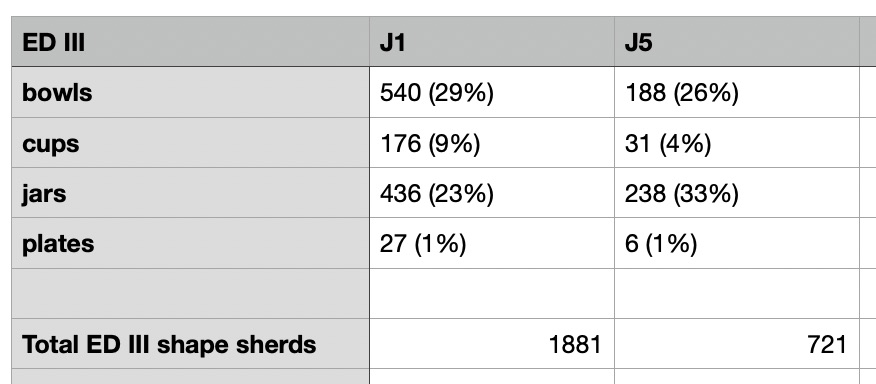
ED III totals from J1 and J5
From the earliest ED III strata, with a total of 264 identifiable shapes, the largest number were bowls (99 examples, 38%) followed by jars (75 examples, 29%) and a much smaller number of plates (4)and pots (1). Interestingly in this phase there were 13 casserole shapes (5%), dating to the earlier LC3 strata mixed in with the early ED III sherds.

ED III shapes
Conical cups are the prevalent cup type in early ED III; they are produced in coarser examples of Simple ware than in late ED III. Considering all the jar types dating to early ED III in J1 and J5, we have the largest number in the various categories of necked jars many of which, especially the restricted necked jars category, had folded grooved rims. In the ED III strata these medium necked jars with globular, cylindrical and ovoid body shapes are made throughout the period; however the early ED III examples have a deeper and wider groove than later examples.
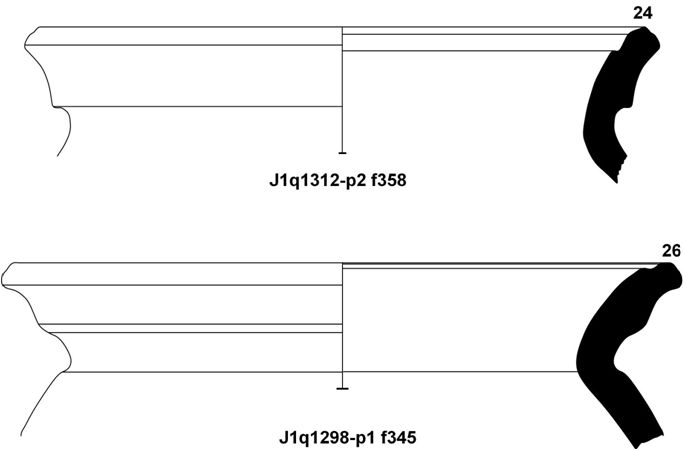
Early ED III Folded Rim Jars from J1, from below Escarpment 1
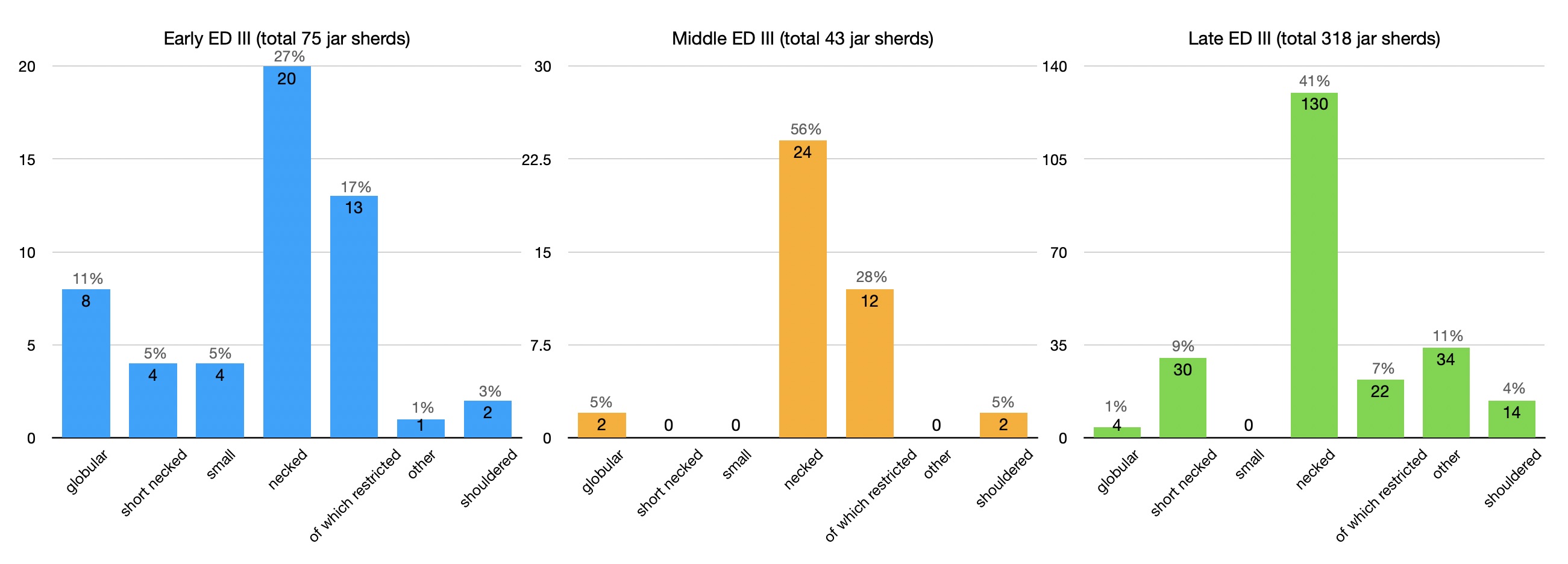
ED III jars
In the middle ED III transition between early and late ED III, bowls with 55 examples (34%) and jars with 43 examples (27%) are the most prevalent. The folded rim jars continue in both the globular and cylindrical body shapes from early ED III but now the grooves are diminishing in both depth and thickness, perhaps signalling a decline in the need for a firm covering for these contents. In this phase a flaring rim jar with a globular body appeared and continues to a lesser extent in late ED III. Sherds of Late Chalcolithic casseroles are found now in only 2 examples.
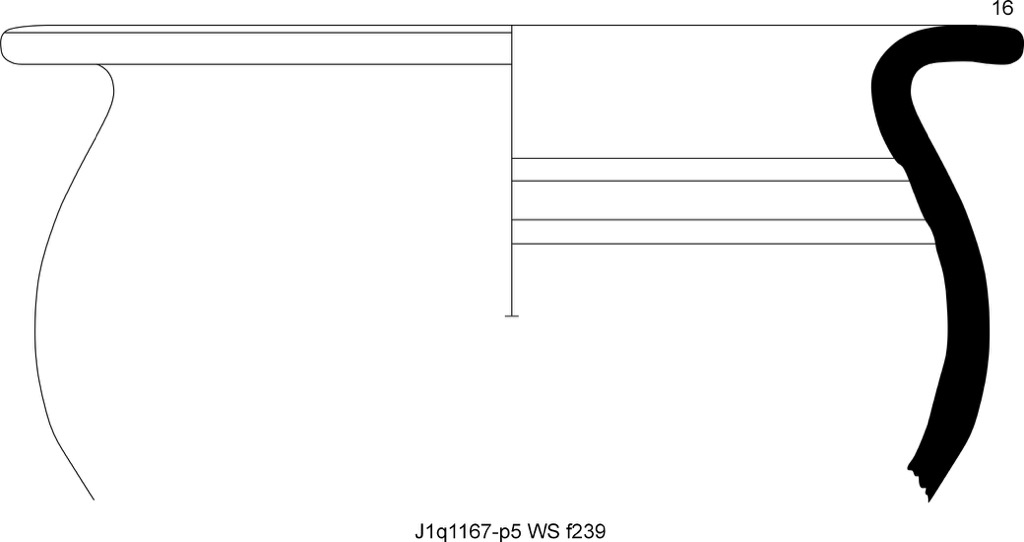
Flaring rim jar
Looking at late ED III where there are a larger number of identifiable shape sherds (totaling 1455), bowls continue to be the most common vessel type at 386 examples (27%) followed by jars (318 examples (22%). Cups with 124 examples (9%) and plates, 22 examples (2%) are the next largest categories followed by small numbers of bottles, pots and strainers. Our evidence shows that folded rim jars with an interior groove are the most common jar type but now are mainly produced with a cylindrical body and a narrower and shallower groove in the rim. In the category of bowl types an open bowl with straight sides and squared rim is the most common large and medium bowl. Conical cups increase gradually within the ED III strata and by late ED III amount to 95% of the cups in J1 and J5. (On ED III Urkesh ceramics see my article “Continuity and Innovation at Urkesh in the ED III Period.”)
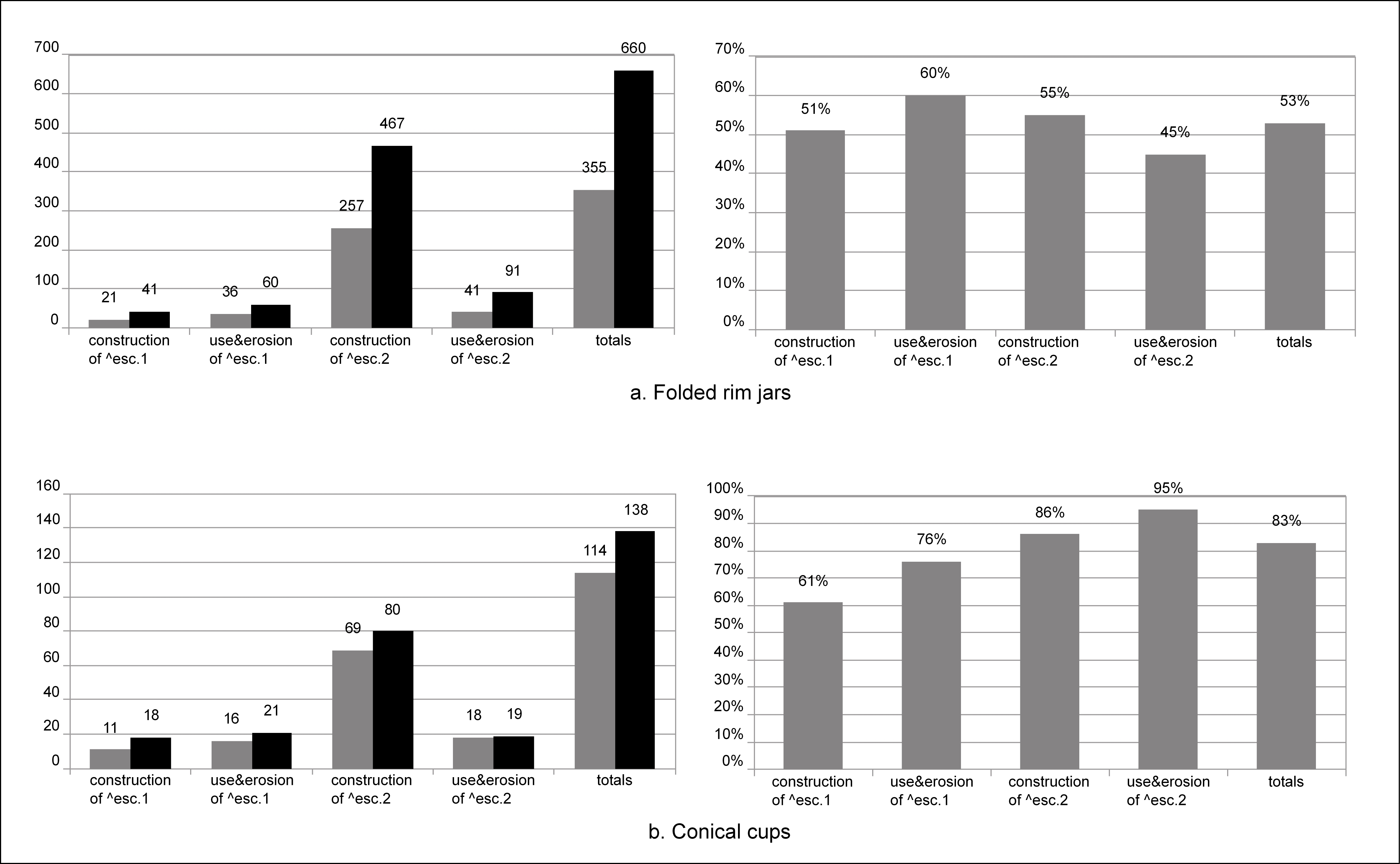
Folded rim jars and cups
Focusing on the wares in these same strata we see that the wares used are quite similar during the entire ED III period. P ware, the cooking ware, stays at or near 5% throughout. A more numerous ware type is S, Simple ware, which is only 4% in the construction of escarpment 1 but later in the period is found in greater numbers. WS, Wet Smooth ware, is more common during the construction of escarpment 1 (15%) and interestingly is found again important in the construction phase of escarpment 2 (17%) while in the use and erosion phases of both escarpments it is only between 15% and 10% respectively. The most common ware during the whole period is CH, Chaff Tempered ware. It increases from the earliest part of the period at 18% and ends being 33% in the latest ED III. CH and WS wares are used for the construction of larger vessels and we see from our numbers that CH gradually overtakes WS; in the use and erosion of escarpment 2 phase WS is only 10% while CH is 33%. This gradual decline in WS use continues into the Akkadian period when most large vessels are constructed in CH ware.

ED III wares (escarpment 1-2)
Back to top: Overview
Ceramics from K1 and OH2 excavation units
In area K1, immediately outside the Inner City Wall, the discarded material from a destroyed building was found against the exterior base of the wall in K1f16. The ceramics and seal impressions from this excavation are dated to early ED III.
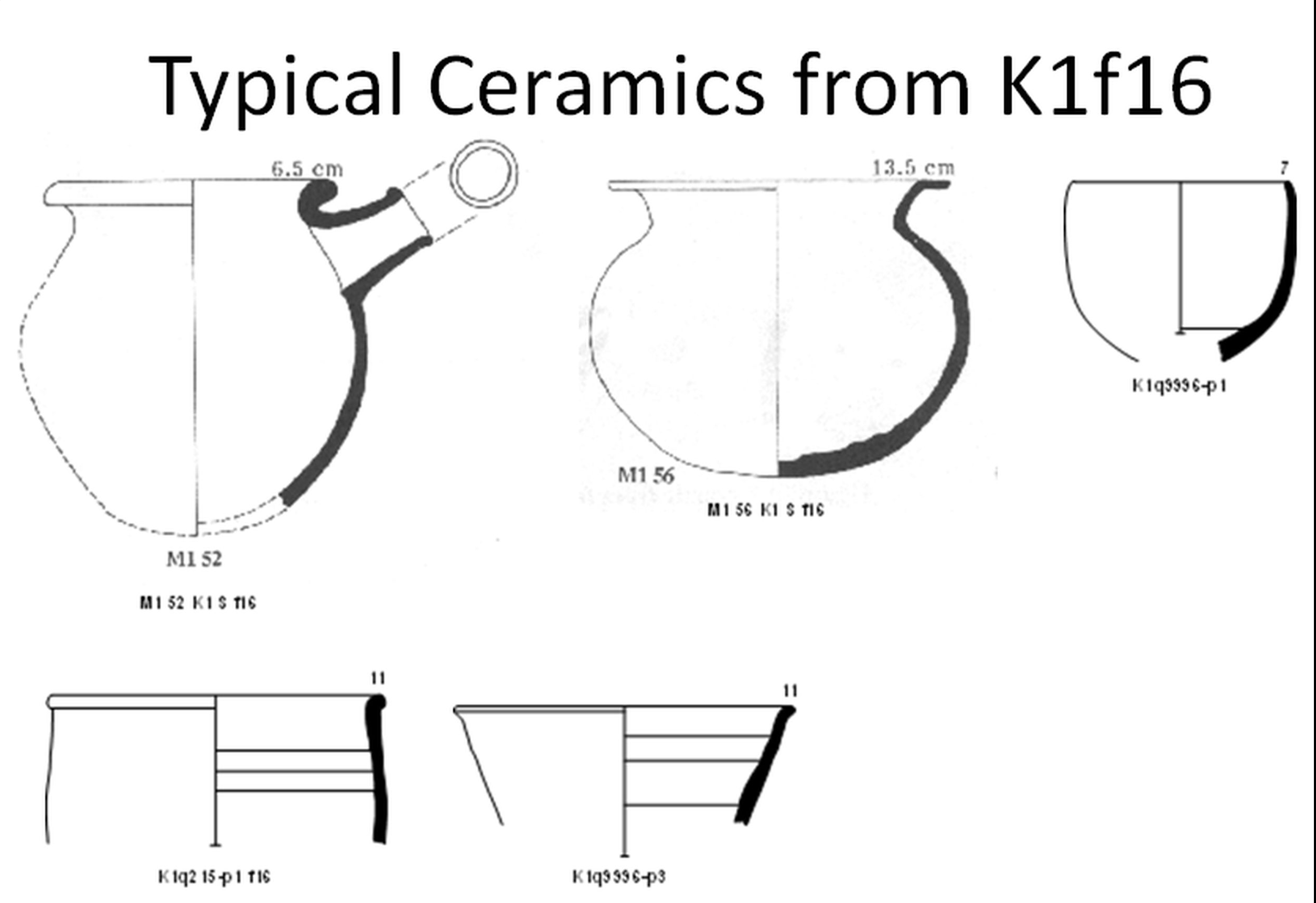
K1f16 ceramics
For a description of the early ED III ceramics in OH2 see OH2 ceramics; cf. also this image.
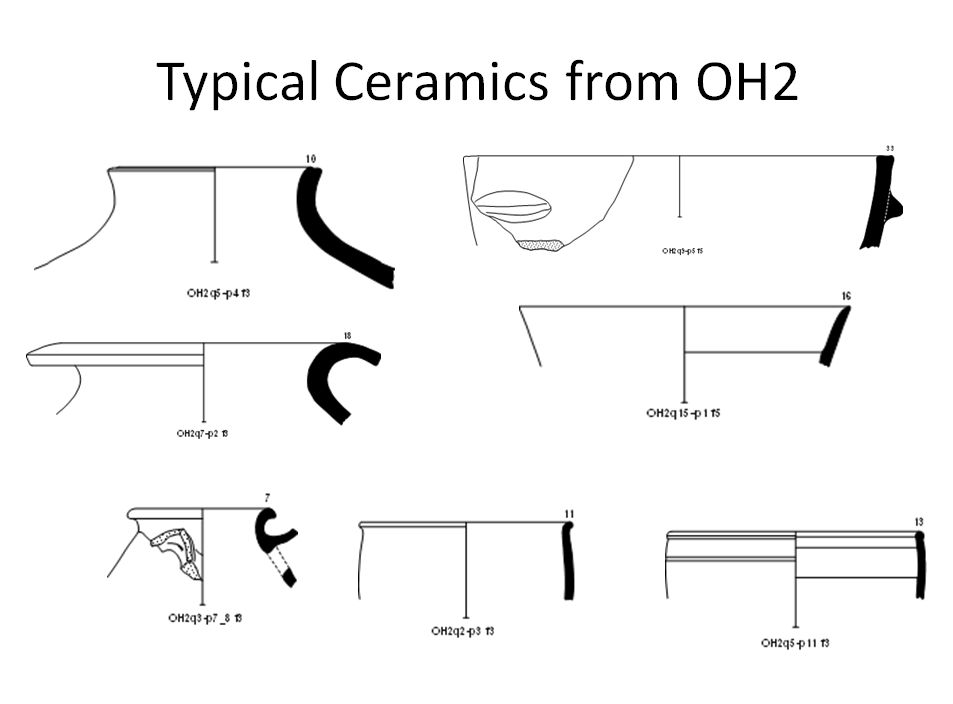
OH2 ceramics
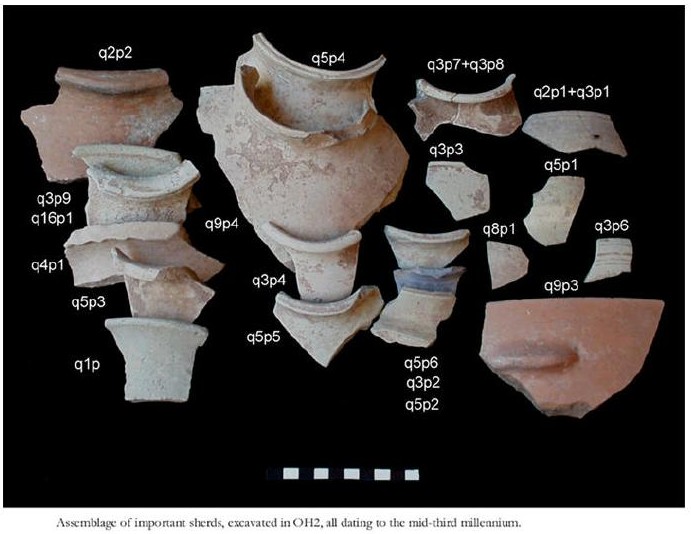
OH2 ceramic assemblage
Back to top: Overview